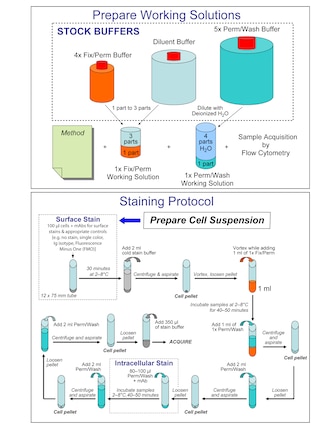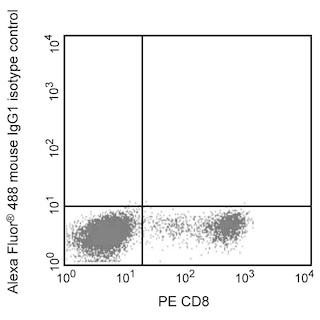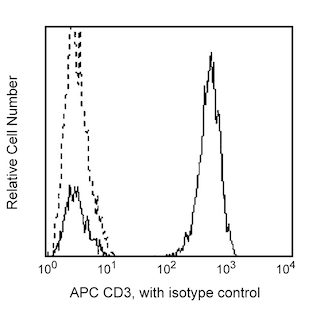-
Your selected country is
Middle East / Africa
- Change country/language
Old Browser
This page has been recently translated and is available in French now.
Looks like you're visiting us from {countryName}.
Would you like to stay on the current country site or be switched to your country?


.png)

Multicolor flow cytometric analysis of Aiolos expression in human peripheral blood lymphocytes. Human whole blood was treated with BD Pharm Lyse™ Lysing Buffer (Cat. No. 555899) to lyse erythrocytes. The leucocytes were washed and then stained with APC Mouse Anti-Human CD3 antibody (Cat. No. 555335/561810/561811; Left Panels) and PerCP-Cy™5.5 Mouse Anti-human CD19 antibody (Cat. No. 340951; Right Panels). The cells were subsequently fixed and permeabilized with the BD Pharmingen™ Transcription Factor Buffer Set (Cat. No. 562574/562725) and stained with either Alexa Fluor® 488 Mouse IgG1, κ Isotype Control (Cat. No. 557721; Lower Panels) or Alexa Fluor® 488 Mouse Anti-Human Aiolos antibody (Cat. No. 565216; Upper Panels). Two-color flow cytometric contour plots showing the correlated expression of Aiolos (or Ig Isotype control staining) versus CD3 or CD19 were derived from gated events with the forward and side-light scattering characteristics of intact lymphocytes. Flow cytometric analysis was performed using a BD™ LSR II Flow Cytometer System.
.png)

BD Pharmingen™ Alexa Fluor® 488 Mouse Anti-Human Aiolos
.png)
Regulatory Status Legend
Any use of products other than the permitted use without the express written authorization of Becton, Dickinson and Company is strictly prohibited.
Preparation And Storage
Product Notices
- This reagent has been pre-diluted for use at the recommended Volume per Test. We typically use 1 × 10^6 cells in a 100-µl experimental sample (a test).
- An isotype control should be used at the same concentration as the antibody of interest.
- Caution: Sodium azide yields highly toxic hydrazoic acid under acidic conditions. Dilute azide compounds in running water before discarding to avoid accumulation of potentially explosive deposits in plumbing.
- Source of all serum proteins is from USDA inspected abattoirs located in the United States.
- The Alexa Fluor®, Pacific Blue™, and Cascade Blue® dye antibody conjugates in this product are sold under license from Molecular Probes, Inc. for research use only, excluding use in combination with microarrays, or as analyte specific reagents. The Alexa Fluor® dyes (except for Alexa Fluor® 430), Pacific Blue™ dye, and Cascade Blue® dye are covered by pending and issued patents.
- Alexa Fluor® 488 fluorochrome emission is collected at the same instrument settings as for fluorescein isothiocyanate (FITC).
- Alexa Fluor® is a registered trademark of Molecular Probes, Inc., Eugene, OR.
- For fluorochrome spectra and suitable instrument settings, please refer to our Multicolor Flow Cytometry web page at www.bdbiosciences.com/colors.
- Please refer to www.bdbiosciences.com/us/s/resources for technical protocols.
Companion Products






The S50-895 monoclonal antibody specifically recognizes the transcription factor, Aiolos, which is encoded by IKZF3, IKAROS family zinc finger 3. Aiolos belongs to the Ikaros family of zinc-finger proteins that includes Ikaros and Helios. Aiolos can form homodimers or heterodimers with other Ikaros family members. Multiple Aiolos isoforms have been described. Aiolos is expressed in committed lymphoid progenitors and mature types of T and B lymphocytes, but is not expressed by hematopoietic stem cells. Aiolos plays an important role in the control of B lymphocyte differentiation and proliferation and is specifically required for the generation of long-lived, high affinity plasma cells in the bone marrow. Aiolos is involved in regulating BCL2 expression and controlling apoptosis in T-cells in an IL2-dependent manner. Aberrant expression of IKZF3 has been implicated with leukemogenesis and certain autoimmune diseases.
Development References (8)
-
Billot K, Parizot C, Arrouss I, et al. Differential aiolos expression in human hematopoietic subpopulations. Leuk Res. 2010; 34(3):289-293. (Biology). View Reference
-
Billot K, Soeur J, Chereau F, et al. Deregulation of Aiolos expression in chronic lymphocytic leukemia is associated with epigenetic modifications. Blood. 2011; 117(6):1917-1927. (Biology). View Reference
-
Liippo J, Nera KP, Veistinen E, et al. Both normal and leukemic B lymphocytes express multiple isoforms of the human Aiolos gene. Eur J Immunol. 2001; 31(12):3469-3474. (Biology). View Reference
-
Morgan B, Sun L, Avitahl N, et al. Aiolos, a lymphoid restricted transcription factor that interacts with Ikaros to regulate lymphocyte differentiation. EMBO J. 1997; 16(8):2004-2013. (Biology). View Reference
-
Rebollo A, Ayllon V, Fleischer A, Martinez CA, Zaballos A. The association of Aiolos transcription factor and Bcl-xL is involved in the control of apoptosis. J Immunol. 2001; 167(11):6366-6373. (Biology). View Reference
-
Romero F, Martinez AC, Camonis J, Rebollo A. Aiolos transcription factor controls cell death in T cells by regulating Bcl-2 expression and its cellular localization. EMBO J. 1999; 18(12):3419-3430. (Biology). View Reference
-
Schmitt C, Tonnelle C, Dalloul A, Chabannon C, Debre P, Rebollo A. Aiolos and Ikaros: regulators of lymphocyte development, homeostasis and lymphoproliferation. Apoptosis. 2002; 7(3):277-284. (Biology). View Reference
-
Wang JH, Avitahl N, Cariappa A, et al. Aiolos regulates B cell activation and maturation to effector state. Immunity. 1998; 9(4):543-553. (Biology). View Reference
Please refer to Support Documents for Quality Certificates
Global - Refer to manufacturer's instructions for use and related User Manuals and Technical data sheets before using this products as described
Comparisons, where applicable, are made against older BD Technology, manual methods or are general performance claims. Comparisons are not made against non-BD technologies, unless otherwise noted.
For Research Use Only. Not for use in diagnostic or therapeutic procedures.
Report a Site Issue
This form is intended to help us improve our website experience. For other support, please visit our Contact Us page.